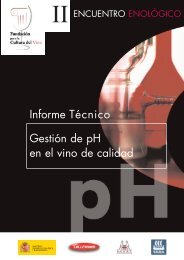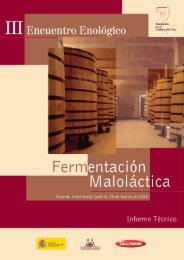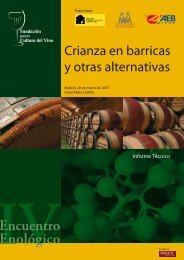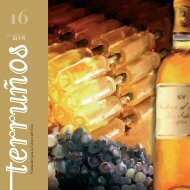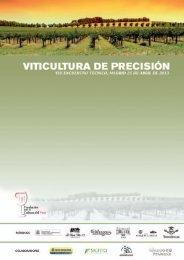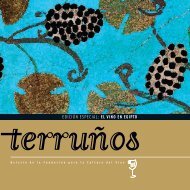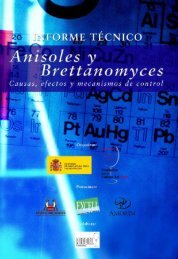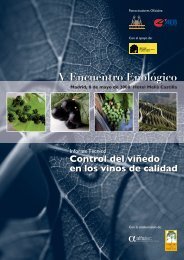Compuestos azufrados volátiles en vinos - Fundación para la ...
Compuestos azufrados volátiles en vinos - Fundación para la ...
Compuestos azufrados volátiles en vinos - Fundación para la ...
You also want an ePaper? Increase the reach of your titles
YUMPU automatically turns print PDFs into web optimized ePapers that Google loves.
Nitrog<strong>en</strong>managem<strong>en</strong>t iscritical for wineManaging Director,f<strong>la</strong>vour and styleUgliano, M.; H<strong>en</strong>schke, P.A.; Herderich, M.J.; Pretorius,I.S.The Australian Wine Research Institute, PO Box 197, Gl<strong>en</strong>Osmond (Ade<strong>la</strong>ide), South Australia 5064, Australia“Winemaking begins in the vineyard” is a mantrathat has widespread support amongst winemakers.It conveys the concept of vineyard or, in Fr<strong>en</strong>ch jargon,terroir as an intrinsic property of grape, andconsequ<strong>en</strong>tly the corresponding wine. There is nodoubt that many great wines are associated withgreat vineyards. So, where do yeast fi t in?The perception that ferm<strong>en</strong>tation yeast faithfullytransform grape must into wine has be<strong>en</strong> changingin the detail over the past decades. This is a result ofsci<strong>en</strong>ce uncovering the many roles that yeast perform,and the wider selection of strains avai<strong>la</strong>ble thatpromote these various attributes. For example, whereasmost strains produce a re<strong>la</strong>tively simi<strong>la</strong>r, g<strong>en</strong>eric,ferm<strong>en</strong>tation bouquet only some strains possess astrong ability to hydrolyse cysteine conjugates responsiblefor Sauvignon B<strong>la</strong>nc character, meaning thatonly selected strains can <strong>en</strong>hance varietal expression(Swiegers et al. 2006).Winemakers today have many options through ferm<strong>en</strong>tationmanagem<strong>en</strong>t to <strong>en</strong>hance the varietal characteristicsof their wine, or to express further regiona<strong>la</strong>ttributes. Furthermore, yeast strongly respond totheir <strong>en</strong>vironm<strong>en</strong>t. It is well known that temperatureaff ects the rate of ferm<strong>en</strong>tation, that grape solids<strong>en</strong>hance survival and that high osmotic stress, asimposed by a Botrytis-aff ected must, leads not onlyto increased glycerol production but also to highervo<strong>la</strong>tile acidity. The <strong>la</strong>tter example highlights the remarkableability of yeast to adapt to stressful (i.e. highsugar) <strong>en</strong>vironm<strong>en</strong>ts. However, there is an accompanyingmetabolic adaptation which can have positive ornegative fl avour implications.At the time of inocu<strong>la</strong>tion, yeast are subjected to arange of stresses to which the cell must adapt in orderto exploit its new <strong>en</strong>vironm<strong>en</strong>t. Some of the knownstresses are osmotic pressure, oxidative conditions,Seminario Técnico<strong>Compuestos</strong> <strong>azufrados</strong> volátiles <strong>en</strong> <strong>vinos</strong>sulphite toxicity and temperature shock (Bauer andPretorius 2000). Nutri<strong>en</strong>ts, whether pres<strong>en</strong>t in sub- orsuper-optimal conc<strong>en</strong>tration, can also induce stressand metabolic responses. The primary response isaimed at protecting the cell from committing to reproductionwh<strong>en</strong> key nutri<strong>en</strong>ts are <strong>la</strong>cking or dealingwith pot<strong>en</strong>tial toxicity wh<strong>en</strong> the conc<strong>en</strong>tration is outsidethe normal range. The metabolic response oft<strong>en</strong>involves a cascade of biochemical reactions, some ofwhich can lead to altered metabolism of nutri<strong>en</strong>tssuch that the yeast will secrete <strong>en</strong>d-products in differ<strong>en</strong>t amounts (Albers et al. 1998). Some of the <strong>en</strong>dproducts that have s<strong>en</strong>sory properties can lead tochanges in the fl avour profi le of the wine. H 2S formationis an all-too-well known example re<strong>la</strong>ting tonitrog<strong>en</strong> depletion stress.Clearly, the vineyard <strong>en</strong>vironm<strong>en</strong>t and interv<strong>en</strong>tionby the viticulturist shape the developm<strong>en</strong>t of the vineand especially the composition of the grape. Becausethe viticulturist attempts to ba<strong>la</strong>nce a long list of prioritiesin order to produce fruit to specifi cation, mostatt<strong>en</strong>tion will focus on those factors that cannot bemodifi ed once the fruit has be<strong>en</strong> harvested.Therefore, yeast nutri<strong>en</strong>ts, especially nitrog<strong>en</strong>, mightnot be optimised for ferm<strong>en</strong>tation, <strong>la</strong>rgely in the beliefthat nutri<strong>en</strong>ts can be easily corrected in the winery. Giv<strong>en</strong>that we estimate that up to 500t of diammoniumphosphate (DAP) could be used each year to produceAustralian wine, is this winemaking input being usedeff ectively? Our curr<strong>en</strong>t state of knowledge on theimplications of controlling vineyard nitrog<strong>en</strong> as opposedto ferm<strong>en</strong>tation nitrog<strong>en</strong> on ferm<strong>en</strong>tation performanceand wine composition has be<strong>en</strong> rec<strong>en</strong>tly reviewedby Bell and H<strong>en</strong>schke (2005). In this article, wewill focus on the role that ferm<strong>en</strong>tation nitrog<strong>en</strong> hasin modu<strong>la</strong>ting metabolism and some of the changesthat this can have on wine fl avour. We will fi rst summarisecurr<strong>en</strong>t best practice for managing ferm<strong>en</strong>tationnitrog<strong>en</strong> and th<strong>en</strong> describe the main fl avourchanges that are aff ected by nitrog<strong>en</strong>.Finally, we will consider the fl avour implications of nitrog<strong>en</strong>for white and red wine ferm<strong>en</strong>tations.CURRENT BEST PRACTICE FORMANAGING FERMENTATION NITROGENA common practice amongst winemakers is to makea standard addition of DAP to the juice or must (100-300mg/L) at inocu<strong>la</strong>tion without measuring the nitrog<strong>en</strong>conc<strong>en</strong>tration. This article will show that DAPaddition has signifi cant fl avour consequ<strong>en</strong>ces andthat measuring the initial nitrog<strong>en</strong> conc<strong>en</strong>tration providesthe opportunity to adjust DAP addition not onlyto achieve an adequate ferm<strong>en</strong>tation rate, but also tomore reliably guide the fl avour profi le and style ofwine required. This work is still in a conceptual stageTextos asociadosWine Industry Journal > Vol 22 No 6 > November / December 200763



